THE THEATRE ORGAN
PART TWO: BUILDERS OF THE THEATRE ORGANS
THIS PAGE IS WRITTEN IN CONJUNCTION WITH GLEN TWAMLEY (FRIENDS OF BEER WURLITZER)
-oOo-
PAGE TWENTY-THREE:
THE CHRISTIE THEATRE ORGAN CONTINUED
THE REGAL CINEMA MARBLE ARCH
Hill, Norman & Beard had the honour of being the makers of the largest Theatre Organ constructed outside of the U.S.A. This Christie Organ, which had the Job Number 2688, was installed at the Regal Cinema Marble Arch in 1928 and had 4-manuals, 36-ranks consisting of 2,300 pipes, and a Carillon of 32 bells, the largest bell weighing half a ton.
This was one of the few Theatre Organs to possess a genuine 32-foot rank. Most Theatre Organs were built without this rank; however some had a resultant 32-foot pedal stop, which was able to trick the human ear into thinking it was hearing the 32-foot pitch by causing two 16-foot pipes to sound in combination.
Quentin Maclean was the cinema’s Chief Organist from its opening until 1932 when left to take up the same post at the Trocadero at the Elephant & Castle. Between 1930 and 1932, Reginald Foort held this position and from 1932 until 1934, Sidney Torch, who had been the Assistant to the Chief Organist since 1928, took over as Chief.
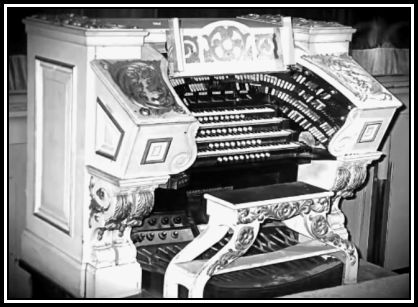 The Christie Theatre Organ of the Regal Cinema Marble Arch
The Christie Theatre Organ of the Regal Cinema Marble Arch
Quentin Maclean playing Songs from 1930 on The Christie Theatre Organ of the Regal Cinema Marble Arch
Reginald Foort playing Whistling in the Dark on The Christie Theatre Organ of the Regal Cinema Marble Arch
Sidney Torch playing Orient Express (1935) at a Wurlitzer Theatre Organ
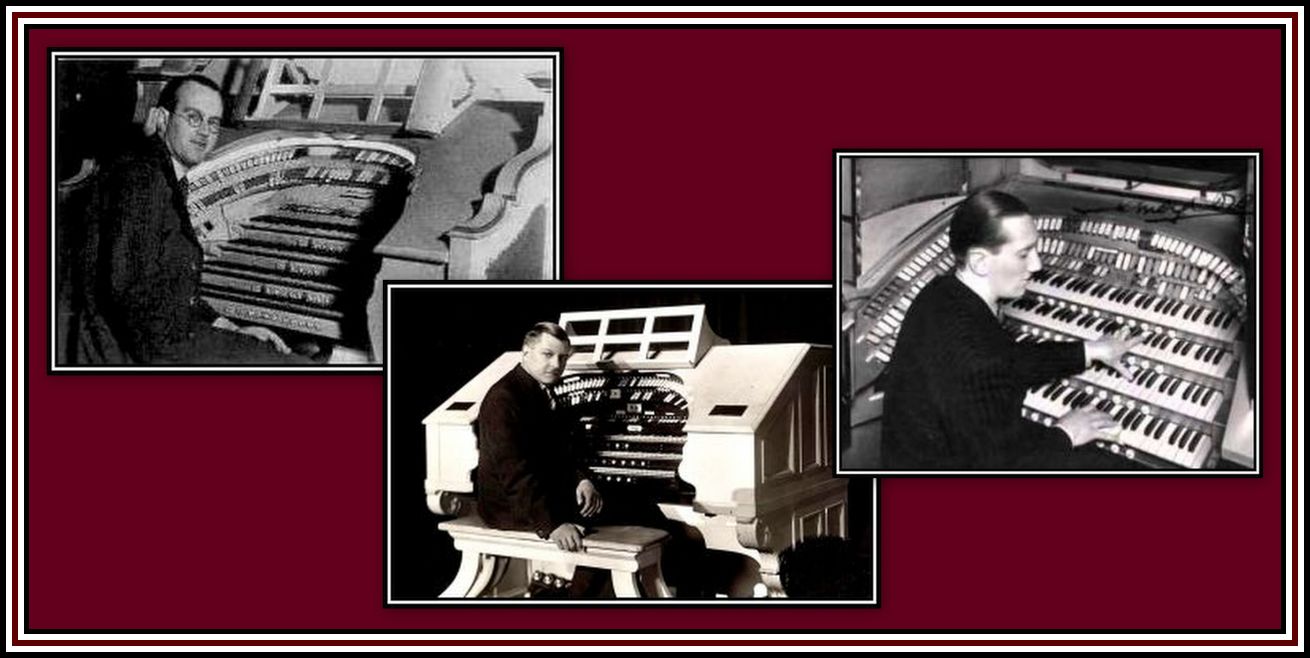 Left: Quintin Maclean; Middle: Reginald Foort; Right: Sidney Torch
Left: Quintin Maclean; Middle: Reginald Foort; Right: Sidney Torch
Quentin Maclean playing Rhapsody in Blue on
The Christie Theatre Organ of the Regal Marble Arch
-oOo-
There has been speculation that The Christie Theatre Organ of the Regal Cinema Marble Arch was, in fact, not a true Theatre Organ, rather a crossover instrument, something akin to a Concert Organ. However this is not really correct. Some of the ranks were not extended as fully as one would see in a typical Theatre Organ of the 1930s, and the Great (second) manual played only ranks from Chamber A, while the Orchestral (third) manual played only ranks from Chamber B; but these features were not unique on early British Theatre Organs. There were Mixture stops, and some of the wind pressures were lower than usual (while others were higher), but overall this was definitely a Theatre Organ; the ultimate silent film accompaniment instrument.
Since the Regal Cinema Marble Arch opened in 1928, plans for the Organ were most certainly drawn up prior to this date. The Unified Extension Cinema Organ was in its infancy at this time, having only been introduced to the U.K. when the first Wurlitzer Theatre Organs were imported from the U.S.A. in 1925 and installed at the Picture House Walsall, the Palace Cinema Tottenham and the New Gallery Cinema. Despite this, the modern Cinema Organ did not really become well known in the U.K. until the 1930s.
The Regal Cinema Marble Arch was a prestigious cinema and it is believed that Hill, Norman & Beard hoped to gain valuable orders following the installation of a special organ here. Accordingly, they added many features to it in order to demonstrate the range that their organs might have. The Company (acting on the instructions of a team of consultants including Quentin Maclean) tended towards established practices in the design of this organ, rather than put their hope into less well tried innovations. This may be seen from an examination of the organ’s specification: the use of independent Great and Orchestral Divisions; and certain ranks which played in only one Division rather than being available in all Divisions.
Listening to The Christie Thatre Organ of the Regal Marble Arch, one can appreciate its depth of tone, which sets it apart from other organs with Consoles of similar size, but which in fact possess far fewer pipes. As a result, these other organs lack the richness and variety of sound associated with this particular Christie Theatre Organ. Thus, the Organ may be considered a transitional instrument, linking the more traditional, large Concert Organs with the newer and smaller Unit Organs produced by Wurlitzer, Compton and Christie.
-oOo-
Part of Hot Dog played by Sidney Torch at
The Christie Theatre Organ of the Regal Cinema Marble Arch.
This piece made use of the tuned Bird Whistles installed in the organ.
-oOo-
Tuned Bird Whistles were also added to The Christie Theatre Organ of the Regal Cinema Edmonton (4-Manuals and 15 Ranks), which was opened in 1934 by Sidney Torch who was known to appreciate this sound while other organists did not.
-oOo-
The Regal Cinema Marble Arch was renamed Odeon in 1945 when it was became part of The Rank Organisation, which continued until 1964 when it was closed and set for demolition. Just prior to this, the Organ was removed and sold to a private owner living in Cornwall. It remained in storage for the next four decades with any supposed plans for its installation never being realised. Following the owner’s death in 2006, the Organ was purchased by a consortium of Theatre Organ enthusiasts dedicated to its preservation and installation in a public venue. The instrument’s condition was found to be better than some had feared, although a full restoration will be necessary.
Given the Organ’s size and complexity, finding a suitable venue will be a challenge. At the Regal Cinema Marble Arch, the Organ chambers were very cramped, making it difficult for tuning and maintenance to be undertaken. In addition, the restrictive quarters meant that some of the ranks were not ideally positioned relative to the swell shutters, impacting the egress of sound into the auditorium. It is hoped that these issues can be addressed in the next installation, and that this unique and significant organ may one day be heard at its best by an appreciative audience.
-oOo-
Gerald Shaw was resident organist at the Odeon Theatre Swiss Cottage before becoming the last resident organist at the Odeon Theatre Marble Arch (the name change took place in 1945; see below). Mr. Shaw remained in residence here from 1953 until 1958 when he was transferred to the Odeon Theatre Leicester Square. During his tenure at the Odeon Theatre Leicester Square, he would occasional return to the Odeon Theatre Marble Arch to play its Christie Theatre Organ.
While at the Odeon Theatre Leicester Square, Mr. Shaw organised a yearly Christmas Bash. Apparently, on one occasion he presented his yule-time extravaganza at the Odeon Marble Arch. It would appear that he was held in high esteem by the Rank Organisation, as he seemed free to do as he wished. Mr. Shaw rated The Christie Theatre Organ at the Odeon Marble Arch highly and ranked it superior to The Duchess at the Odeon Leicester Square. When The Christie Theatre Organ was removed, Mr. Shaw referred to this, as taking an honourable retirement. Sadly, this retirement constituted removal and storage in a number of vans in Cornwall.
From a reader
-oOo-
According to my father, the Regal Cinema Marble Arch was a gem. There were a number of cinemas that my father liked based on their architectural delights. These included, in addition to the Regal Cinema Marble Arch, the Trocadero at the Elephant & Castle,the London Pavilion in Piccadilly Circus and the Regent Brighton; all sadly gone today.
oOo-
Click here to read the article, Sidney Torch Recalled by Lewis Williams
and Click here to read another article on Sidney Torch by David Ades
-oOo-
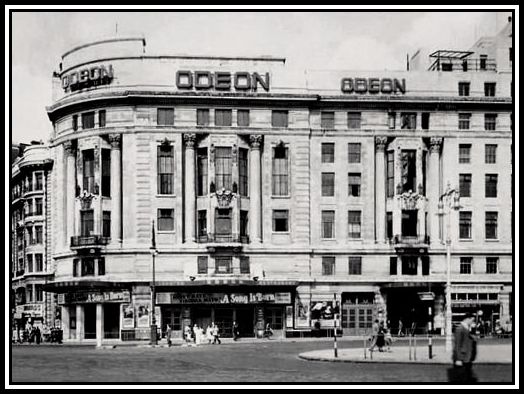 The Regal Cinema Marble once it was taken over by J. Arthur Rank’s Odeon Cinema Circuit
The Regal Cinema Marble once it was taken over by J. Arthur Rank’s Odeon Cinema Circuit
The Regal Cinema Marble Arch opened in 1928, and by all accounts, was spectacular to see. The facade was made of Portland Stone and its interior decor was, in part, in the atmospheric style that had been popularised in many Movie Palaces of the U.S. and executed at the Regal by Charles Muggeridge.
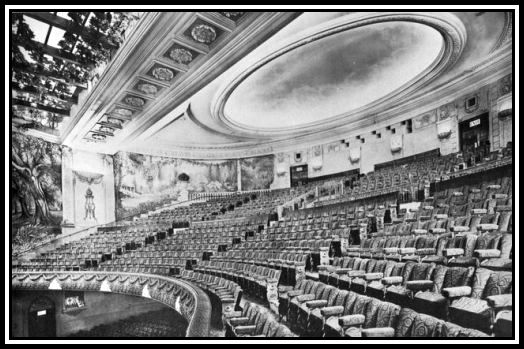 Regal Cinema Marble Arch showing the Circle and part of the Pergola (in the top left hand corner)
Regal Cinema Marble Arch showing the Circle and part of the Pergola (in the top left hand corner)
The decoration was that of a Roman Temple with columns along the side walls and with trees and golden creeper presumably painted between them. The ceiling was painted to resemble the sky together with clouds and stars, visible through a Pergola with golden creeper (a Pergola is a lattice covered walkway apparently; I have seen such walkways many times, but never knew that they had a specific name!).
 The Pergola of High Park, Toronto
The Pergola of High Park, Toronto
-oOo-
In 1929, the cinema was taken over by Associated British Cinema Circuit (ABC) who continued to operate it until 1945. The cinema had been taken over by The Rank Organisation in 1945 and was set to reopen as an Odeon Theatre, but was damaged by the last V-2 Bomb to hit London during the Second World War. The Rank Organisation, following its repair, finally opened the Odeon Theatre Marble Arch in September 1945 and continued to operate it until March 1964 when it was closed and demolished.
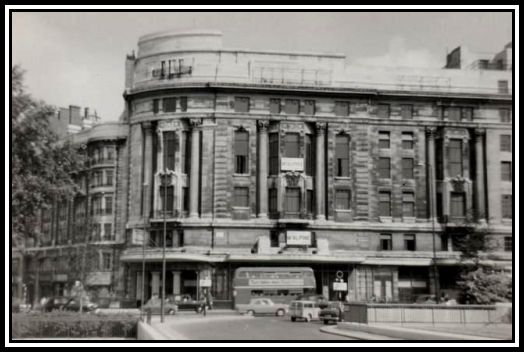 The Odeon Theatre Marble Arch just as the demolition process was about to begin
The Odeon Theatre Marble Arch just as the demolition process was about to begin
-oOo-
When I was a child, there were several cinemas in the Marble Arch area, the most notable being the Odeon and the Pavilion. I was fortunate to be taken to both cinemas. I remember the Pavilion Cinema Marble Arch. I thought it an attractive cinema and recall that it had a number of columns at the entrance. The cinema was built in 1914 and was part of the Pavilion chain operated by Israel Davis. In 1927, its operation was taken over by Gaumont British Cinemas Limited but its name remained unchanged. Apparently, a 3 manual, 10 rank Christie Theatre Organ was installed at this time, replacing the Jones Organ than was present earlier. However it was removed in 1948 and exported to South Africa.
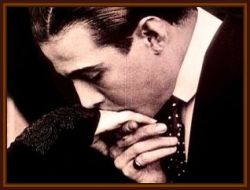
The Pavilion Cinema Marble Arch holds several distinctions: in 1924, it was the first cinema visited by a reigning monarch; it was visited by Rudolph Valentino in 1925; and was one of the Gaumonts chosen for presentation of the Baird System of Big Screen Television in 1939.
The cinema passed to the Archway Company in the early 1950s, but was eventually closed and demolished in the mid-1950s and replaced by a variety of shops.
-oOo-
I went to the Pavilion Cinema Marble Arch only once and that was to see the film The Snake Pit here. I suspect that my parents had not realised what this film was about, as I am sure they would never have knowingly taken me to see it. However, I do recall sleeping through most of it. This film was controversial when first released since it was one of the first films to deal with mental illness. I was impressed with the cinema since it had sunken lighting, which I had not seen before.
I remember going to the Odeon Theatre Marble Arch on several occasions as a child, as it was a special favourite of my father’s. I don’t know why he liked it so much, but then I recall little about its decoration except for the ceiling. Perhaps he liked it more than other cinemas since he may have seen some films there that appealed to him as a young man. However, he was fond of gardens, so perhaps The Pergola appealed to him. I know that it must have appealed to me!
-oOo-
In the mid-1950s, a number of 20th Century Fox productions in CinemaScope were shown here. Most of the films shown at this time were transfers from the Carlton or Rialto Cinemas that were more centrally located. Unfortunately the popularity of the Odeon Theatre Marble Arch wained since its location isolated it from the major West End Showcase Cinemas, which was added to once the Pavilion Cinema closed.
-oOo-
A new cinema was incorporated in the building constructed on the site of the former Odeon Theatre Marble Arch, which was also called the Odeon. The new cinema opened in February 1967 and was remarkable for the huge screen installed.
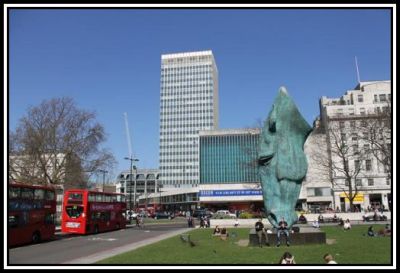 The new Odeon Cinema Marble Arch
The new Odeon Cinema Marble Arch
In September 1996, the Odeon Cinema Marble Arch was closed suddenly and converted into a five-screen multiplex.
-oOo-
A reader has informed me that the former Majestic Cinema in Cradley Heath had a Christie Theatre Organ with 3-manuals and 10-ranks installed in 1933, which has not been seen or heard of in years. When the Majestic closed as a cinema and became a Bingo Social Club, the Organ remained in place and was played during sessions. However, since the final closure, the building has been boarded up completely and no one from any Organ Group has managed to get inside in order to check on the state of the instrument. So, unless the metal men have removed the pipework, it is probably still present and slowly rotting away!
——oooOOOooo——
ACKNOWLEDGEMENTS
I would like to thank Mr. Ian McIver for his help and kindness in the preparation of this piece.
I would like to thank Mr. Paul Bland for his contributions to this piece.
——oooOOOooo——
Click here to GO to PAGE TWENTY-FOUR of PART TWO:
THE HORWORTH CHRISTIE THEATRE ORGAN:
——oooOOOooo——
——oooOOOooo——
Click here to return to PART ONE:
INTRODUCTION TO THE ORGAN
——oooOOOooo——
Click here to return to PART TWO: THE THEATRE ORGAN HOME PAGE
——oooOOOooo——
——oooOOOooo——

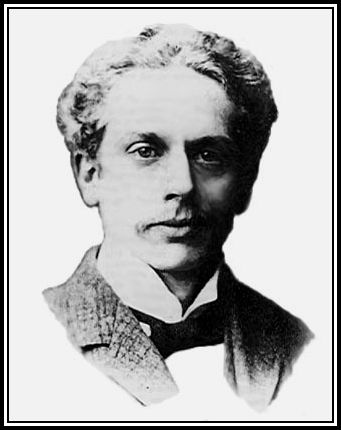
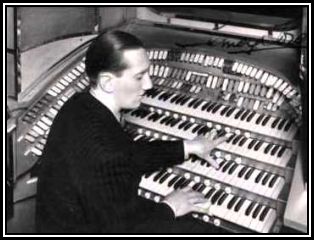
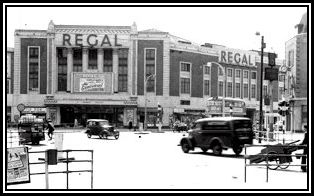
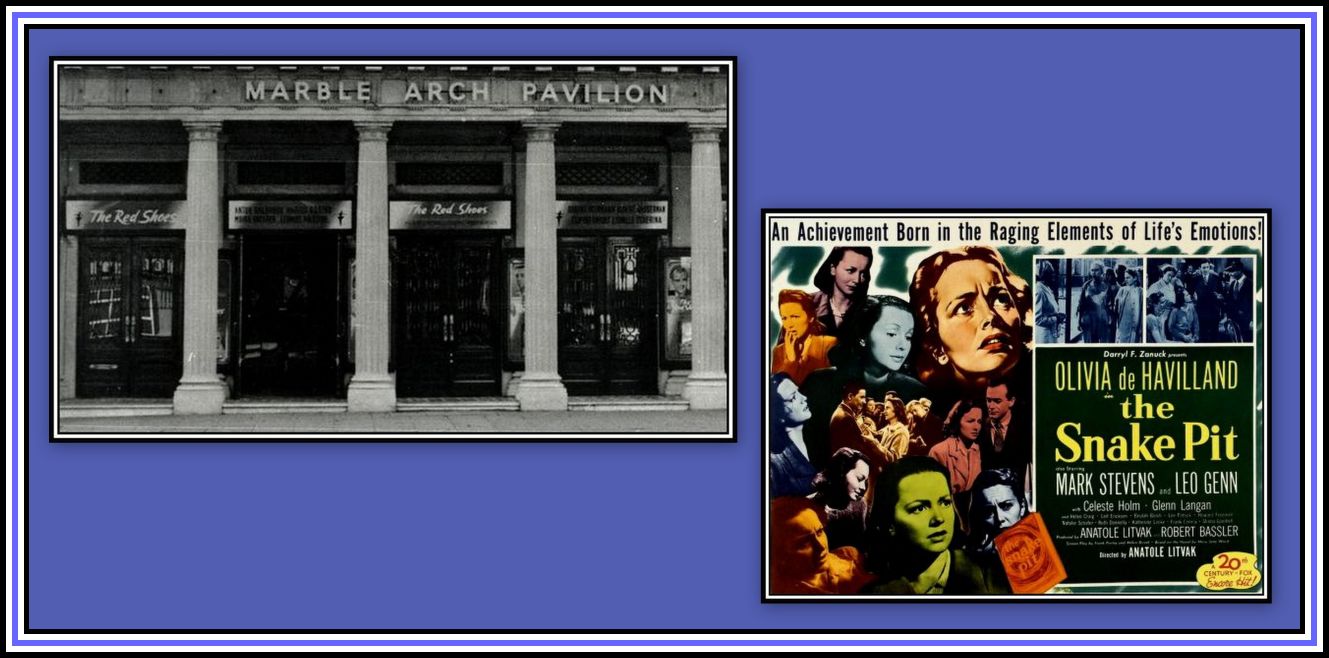
Hi, re the Christie organ at the Majestic Cinema in Cradley Heath – I can confirm that the organ is still there but in a terrible state. If you look it up on an URBEX site called “28 days later” you will find lots of pictures of inside the cinema, which is full of bicycle spares, including the organ console and trodden down pipework spilling out of the chamber. It is a sad but very interesting sight to see.
Ms Brooks: Thank you very much for your comment. I will most certainly check out URBEX and ’28 days later’. With kind regards. Charles Jenkins.